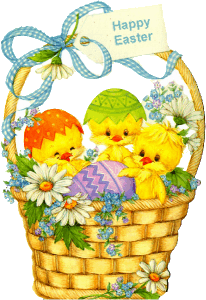|
Easter Eggs The Easter Egg predates the
Christian holiday of Easter. The custom may
have its origin in paganism, for a great many pagan customs, celebrating the
return of spring, gravitated to Easter. The exchange of eggs in the springtime
is a custom that was centuries old when Easter was first celebrated by
Christians. Given as gifts by the ancient Greeks, Persians, and Chinese
at their spring festivals, the egg also appears in pagan mythology,
where we read of the Sun-Bird being hatched from the World Egg. In some
pagan customs, the Heaven and Earth were thought to have been formed
from two halves of an egg. From the earliest times, the egg was a symbol of rebirth in
most cultures, an emblem of the germinating
life of early spring. Eggs were often wrapped in gold leaf or, if you were a
peasant, colored brightly by boiling them with the leaves or petals of
certain flowers.  During
the 4th century consuming eggs during Lent became taboo. However, spring
is the peak egg-laying time for hens, so people began to cook eggs in
their shells to preserve them. Eventually people began decorating and
hiding them for children to find during Easter, which gave birth to the
Easter Egg Hunt. Other egg-related games also evolved like egg tossing
and egg rolling.
Because the use of eggs was forbidden during
Lent, they were brought to the table on Easter Day, coloured red to symbolize
the Easter joy. The recorded history of middle ages is full of such instances.
Edward I's accounts for 1290 include the expense of purchasing hundreds
of eggs to be distributed to his household. In the 17th century, pope
Paul V blessed the humble egg in a prayer to be used in England,
Scotland, and Ireland: "Bless, O Lord, we beseech Thee, this Thy
creature of eggs, that it may become a wholesome sustenance to Thy
faithful servants, eating in thankfulness to Thee, on account of the
Resurrection of Our Lord." This custom is found not only in the Latin but also in the
Oriental Churches. The symbolic meaning of a new creation of mankind by Jesus
risen from the dead was probably an invention of later times. Easter eggs, the children are told, come from Rome with
the bells which on Thursday go to Rome and return Saturday morning. A Polish
folktale tells of the Virgin Mary giving eggs to soldiers at the cross
as she pleaded with them to be merciful. As her tears dropped they
spattered droplets on the eggs mottling them with a myriad of colors. The sponsors
in some countries give Easter eggs to their god-children. Coloured eggs are used
by children at Easter in a sort of game which consists in testing the strength
of the shells (Kraus, Real-Encyklop die, s. v. Ei). Both coloured and uncoloured
eggs are used in some parts of the United States for this game, known as
"egg-picking". Another practice is the "egg-rolling" by
children on Easter Monday on the lawn of the White House in Washington. Children
also hunt colored eggs and place them in Easter baskets along with the
modern version of real Easter eggs -- those made of plastic or chocolate
candy. Children
in France, Holland and England go from house to house asking for Easter
eggs, similar to our custom of Halloween trick-or-treating. German
children are given small presents which are hidden inside imitation
Easter eggs. In
the Russian Orthodox church, eggs are blessed at church during Easter
time and are a special breakfast on Easter morning. In fact
Russia has a special place in the Easter Egg history. In 1883, the
Russian Czar commissioned Peter Faberge to make a special egg for his
wife. Faberge made intricate, delicately decorated eggs which later went
on to be famous as the Faberge egg and is perhaps the best known of all
the decorated eggs. But
believe it or not the Chinese are the first people who painted eggs.
During Spring Festivals almost 3000 years ago, they exchanged red eggs
as part of their celebration.
Back to Easter
Holiday
Index
|